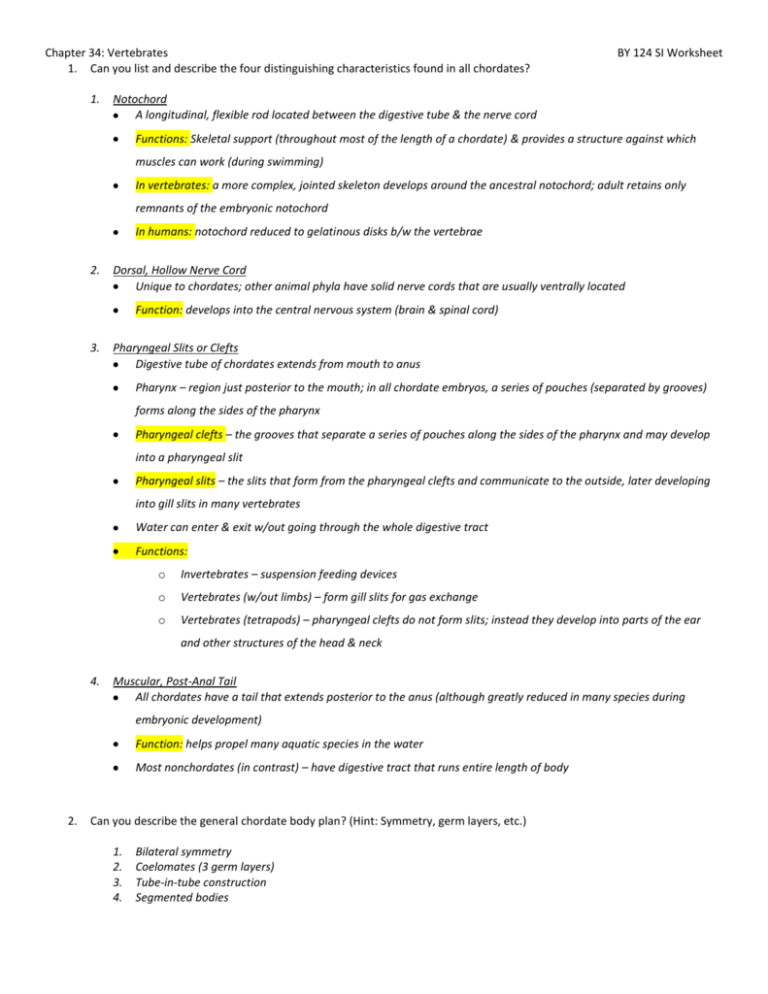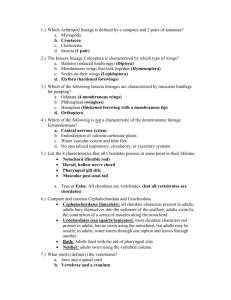Chapter 34: Vertebrates BY 124 SI Worksheet 1. Can you list and
advertisement

Chapter 34: Vertebrates 1. Can you list and describe the four distinguishing characteristics found in all chordates? 1. BY 124 SI Worksheet Notochord A longitudinal, flexible rod located between the digestive tube & the nerve cord Functions: Skeletal support (throughout most of the length of a chordate) & provides a structure against which muscles can work (during swimming) In vertebrates: a more complex, jointed skeleton develops around the ancestral notochord; adult retains only remnants of the embryonic notochord In humans: notochord reduced to gelatinous disks b/w the vertebrae 2. Dorsal, Hollow Nerve Cord Unique to chordates; other animal phyla have solid nerve cords that are usually ventrally located Function: develops into the central nervous system (brain & spinal cord) 3. Pharyngeal Slits or Clefts Digestive tube of chordates extends from mouth to anus Pharynx – region just posterior to the mouth; in all chordate embryos, a series of pouches (separated by grooves) forms along the sides of the pharynx Pharyngeal clefts – the grooves that separate a series of pouches along the sides of the pharynx and may develop into a pharyngeal slit Pharyngeal slits – the slits that form from the pharyngeal clefts and communicate to the outside, later developing into gill slits in many vertebrates Water can enter & exit w/out going through the whole digestive tract Functions: o Invertebrates – suspension feeding devices o Vertebrates (w/out limbs) – form gill slits for gas exchange o Vertebrates (tetrapods) – pharyngeal clefts do not form slits; instead they develop into parts of the ear and other structures of the head & neck 4. Muscular, Post-Anal Tail All chordates have a tail that extends posterior to the anus (although greatly reduced in many species during embryonic development) Function: helps propel many aquatic species in the water Most nonchordates (in contrast) – have digestive tract that runs entire length of body 2. Can you describe the general chordate body plan? (Hint: Symmetry, germ layers, etc.) 1. 2. 3. 4. Bilateral symmetry Coelomates (3 germ layers) Tube-in-tube construction Segmented bodies Chapter 34: Vertebrates 3. BY 124 SI Worksheet How did the number of Hox gene clusters change as the most primitive chordates evolved into craniates and gnathostomes? Earliest chordates (lancelets/tunicates) – one Hox gene cluster Craniates – two Hox gene clusters Gnathostomes – four Hox gene clusters 4. Can you describe the derived characteristics of craniates? Neural crest (unique to craniates) – bilateral band of cells that appears near the margins of the closing neural tube in an embryo; neural crest cells migrate to distant sites in the embryo and give rise to some of the anatomical structures unique to vertebrates: o teeth o bones & cartilage of skull o dermis of facial region o several types of neurons o the sensory capsules (in which eyes & other sense organs develop) In aquatic craniates: pharyngeal clefts evolved into gill slits, which allowed water to be pumped through the slits (using muscles & nerves); functions: assist in sucking in food & facilitates gas exchange Extensive muscular system – muscles lining digestive tract to aid in digestion Two-chambered heart & RBC’s w/ hemoglobin Kidneys – remove waste products from the blood 5. Can you describe the derived characteristics of vertebrates? Underwent gene duplication of the Dlx family – a group of transcription factor genes; resulted in a more extensive skull and a backbone composed of vertebrae In most vertebrates: vertebrae enclose the spinal cord and have taken over the mechanical roles of the notochord Aquatic vertebrates: acquired dorsal, ventral, and anal fins stiffened by fin rays (which provide thrust & steering); also acquired more efficient gas exchange system in the gills 6. Can you describe the derived characteristics of gnathostomes? Jaws evolved from the skeletal rods (two pairs) that previously supported anterior pharyngeal (gill) slits; the remaining gill slits still function as major sites of respiratory gas exchange w/ the external environment Larger forebrain than ancestors – enhanced sense of smell & vision Lateral line system – organs that form a row along each side of the body and are sensitive to vibrations in the surrounding water 7. Which animal retains all four chordate characteristics as an adult? Lancelet 8. Which chordate characteristics are retained by adult tunicates? Pharyngeal slits only! Chapter 34: Vertebrates 9. How do hagfishes defend themselves? BY 124 SI Worksheet Slime glands (buckets of slime!) 10. How do the lampreys eat? Lampreys are the only vertebrates that are parasites! Adults have a round jawless mouth with rasping tongue. They eat by attaching themselves to live fish and ingesting the fish’s blood. 11. Why are conodonts important? Conodonts were the first animals to have mineralized tissues (teeth). 12. What are the earliest gnathostomes on record? Placoderms – “plate-skinned” animals 13. In what two ways do sharks maintain their buoyancy in the water? 1. 2. Excess oil storage in their liver High urea concentrations throughout the body (which makes them hypertonic to their surroundings) 14. In what three ways can baby sharks be born? 1. 2. 3. Oviparous (eggs hatch outside mother’s body) Ovoviviparous (eggs hatch within mother’s uterus) Viviparous (live birth – after being nourished by the placenta in the mother’s uterus) 15. Can you outline the sequential order of chordate structural evolution? (from earliest to latest) Notochord – All chordates! Head – Hagfishes (the first craniates) Vertebral column – Lampreys (the first vertebrates) Jaws & mineralized skeletons – Chondrichthyes (the first gnathostomes) Lungs (or lung derivatives) – Actinopterygii (the first osteichthyans) Lobed fins – Actinistia (lobed-fin fishes) Legs – Amphibians (the first tetrapods) – tetrapods include: Amphibians, Reptiles, Mammals Amniotic egg – Reptiles & Mammals (called amniotes) Milk – Mammals only!











